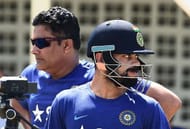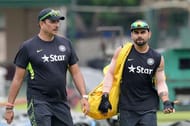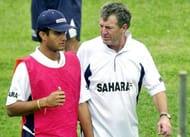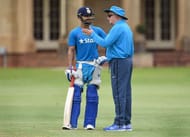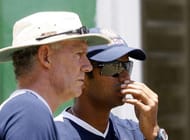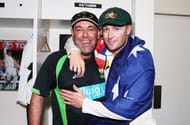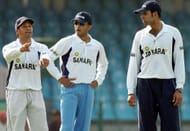Ramachandran Guha said a lot of things in his resignation letter. The former member of the Committee of Administrators (COA) set up by the Supreme Court to supervise the BCCI did not pull any punches. There are some who believe that it was an indictment of Indian Cricket that laid bare the problems inherent in it.
There are others who believe that it was a simplistic, black-and-white point of view that is not in tune with reality. Without choosing a side, I will say that almost everything he said can be healthily debated; if nothing else, it was a very evocative letter.
There are two points in particular that I would like to debate; the notion that players should not have a veto power whilst selecting the coach, and the contention that Anil Kumble should have had his contract as Head Coach extended due to India’s excellent results under his charge.
This was of course borne by the recent rumours and innuendos pertaining to Kumble’s style of coaching. And words like “headmaster” and “intimidating” were used to describe his methods and a perceived clash between Kumble, and the captain, Virat Kohli.
Kohli himself tried to lay the matter to rest by issuing the following statement “See, there has been a lot of speculation, and a lot of things being written by people without actually being a part of the changing room, which is very strange. There are no problems whatsoever. The team is totally focused on the Champions Trophy.”
This itself seems to be in line with another point that Guha made; if the players were unhappy with the coach, why did they wait till the team was already in England for the Champions Trophy to relay those concerns? However, the point of this article is not to debate whether or not there is a rift between Kohli and Kumble.
The point is to write a lot of things about coaching without actually being a part of any changing room, and then critically evaluate whether Anil Kumble should have had his contract extended based purely upon results and whether players deserve a veto power with regards to selecting a coach.
Shane Warne believes that an international cricket team does not need a coach, just a manager. Essentially, if you have been selected to play for your country, you already know what you are doing, and you should be left to your own devices. The logic is sound, but the statement must be considered in light of the fact that Warne was outrageously naturally talented, a genius with supreme self-confidence and more charisma in his pinkie finger than some have in their entire body.
Indeed, the likes of Stuart Broad have spoken glowingly about the skills of specialist fast-bowling coach Steffan Jones, tweeting out the following “I've been lucky to work with some great bowling coaches and big @SteffanJones105 is right up there. Amazing knowledge and top man. Thanks” after a successful BBL stint.
Gary Kirsten was so highly regarded after his stint coaching India, that South Africa hired him after his tenure had ended, hoping that some of the magic would rub off.
There is enough evidence to suggest that Warne is incorrect. Certainly, coaching has value. But what type of value? The characterization of Kumble as a “headmaster” made me think about the role of coaching an international cricket team, and the value added through different approaches.
Related: Reports: Ten Indian players not in favour of Anil Kumble continuing as head coach
The headmaster?
Let us first discuss the ‘’Headmaster” coach. Such an approach focuses on an order; a right place for everything, and everything in its right place. One of Kumble tenants has been a focus upon fitness; a player returning from injury must prove his fitness by playing domestic cricket before he is selected in the squad.
So then, can we postulate that the “Headmaster” is also a taskmaster of sorts? When I think of the “Headmaster” coach, I think of a drill-sergeant imposing a structure of fitness, discipline and order upon his charges.
Andy Flower would fall into this category; he infamously organised a boot-camp before England’s successful Ashes series win in Australia in 2010-11 that built up England’s stamina, resilience, and mental fortitude, but also left James Anderson with a broken rib sustained during a boxing session.
Keaton Jennings has spoken about the work-ethic and discipline instilled into him by his father Ray Jennings, former South Africa and RCB coach. The focus of the “Headmaster” is primarily on improvement through sheer hard work and bloody-mindedness. A proponent of the “practice makes perfect“ point of view, the “Headmaster” believes in constantly moving forward without stopping to smell the roses.
It is hard to argue with the results achieved. India has been very successful under Kumble; recently winning every Test series of their long home season. However, more impressive than the wins were the way they were achieved; through grit and determination and a never-say-die attitude.
This was encapsulated by Cheteshwar Pujara and Wridhiman Saha’s partnership in the Ranchi Test against Australia, where they took the game away from Australia not by dominating them, but by making a series of incremental gains through a refusal to throw their wickets away and to cut out mistakes against a very good bowling effort.
England transformed from soft, underachievers to hard-boiled, bloody-minded cricketers with a mental toughness that caused them to win series in India and Australia, as well as eke out several single-wicket draws.
The “Headmaster” instils the ability to outlast the opposition within his players; they too are hard and ruthless like him. An example of the kind of player that the “Headmaster” tries to create is Jacques Kallis. Matt Prior writes in his autobiography of how he witnessed Jacques Kallis “pounding away on the treadmill in the gym for half an hour as if he had done nothing all day” after having played a match-winning innings and taken wickets for South Africa against England.
The problem with such an approach is that it is likely to alienate some players; players like Warne. It is no coincidence that Warne, that crusader against coaching was coached by John Buchanan. Buchanan too was a proponent of boot-camps and mental toughness. He once famously quoted Sun Tzu’s ‘The Art of War’ to his players and Warne’s shots at him continued long after both had relinquished their roles in the Australian Cricket Team.
Kevin Pietersen was unhappy under Flower, and Flower’s attitude almost robbed England of Ben Stokes when he was sent back early from an England ‘A’ tour of Australia.
Now, it would appear that the players have revolted against Kumble’s methods. Of course, it is thus far all rumour that has been refuted publicly by Kohli but it is worth noting that another rumour said that the players preferred Ravi Shastri’s approach.
Also read: Reports: Virender Sehwag sends a two-line application letter for the job of head coach of India
The Facilitator
I will characterise Ravi Shastri’s approach to coaching as the ‘Facilitator’ approach. Other coaches that fall under this category are Gary Kirsten, Stephen Flemming, John Wright, and Darren Lehmann. The ‘Facilitator’ aims to empower his players; his is a nurturing approach rather than a leading role.
The ‘Facilitator’ is a proponent of the point of view that the coach’s job is to instil self-belief in his players and motivate them to do well. Whereas the ‘Headmaster’ focuses on instilling mental toughness through physically demanding tasks, the ‘Facilitator’ does so through positivity.
Kirsten had arranged for renowned explorer Mike Horn to talk to his players in the past. Horn said that his role was to empower players by helping them find “that passion that drives you to go beyond what you know to be able to progress as a human, to start when all others stop. My role is to be an example to myself and others."
He did so by talking about his own feats, and his thought process whilst achieving them. Horn empowers champion teams; the 2011 Cricket World Cup winning Indian side, the 2014 IPL winning KKR side, and the 2014 Football World Cup winning German side.
The ‘Facilitator’ focuses upon increasing the self-efficacy of players; their belief in their ability to complete the task at hand. Crucially, the ‘Facilitator’ acknowledges the value of intangibles; gut-feeling, self-belief, and a positive mental state.
The ‘Facilitator’ does not aim to bring out the players’ skills through constant repetition; the ‘Facilitator’ creates a culture wherein a player is comfortable in expressing himself. India made it to the semi-finals of the 2015 World Cup, 2016 World T20 and were briefly the number one ranked side in Test Cricket.
Kirsten was famously coach when India won the 2011 World Cup; he trusted MS Dhoni’s decision to promote himself up the order during a difficult chase in the final. Despite his mediocre batting form in the tournament till that point; he scored a match-winning, unbeaten 91, sealing the victory with a six. India also reached the top of the Test Cricket rankings under Kirsten.
John Wright, meanwhile, coached India to the 2003 World Cup final, and the team also began to compete away from home under him. Stephen Flemming, on the other hand, was coach of the wildly successful IPL team CSK.
Darren Lehmann inspired Australia to play positive, attacking cricket at all points; consequences be damned. This approach netted Australia the 2015 World Cup, a 5-0 Ashes victory that also ended the careers of several members of one of England’s greatest sides, and the number one Test Cricket ranking.
Lehmann backed his players to play positively by instilling self-belief and a sense of family and camaraderie, repairing a dressing room that had been fractured under Mickey Arthur.
Crucially, these coaches played to their Captain’s strengths. John Wright gave Sourav Ganguly the space to be the firebrand leader he needed to be. Both Stephen Flemming and Gary Kirsten understood that the buck stopped with MS Dhoni, and focused on implementing his philosophy within the team.
Darren Lehmann’s positive approach fitted perfectly with Michael Clarke’s attacking ethos, as did Ravi Shastri’s with Virat Kohli. These coaches were in part successful because there was synergy between the captain and the coach.
Michael Hussey advanced an interesting theory about John Buchanan’s approach towards Shane Warne. He said “I think the way John spoke to and treated and tried to motivate Shane was genius. He almost tried to get into an argument with him or challenge him with things that were a little bit leftfield. So Shane would say, 'John, you're dribbling rubbish. I'll show you how to do it', and he'd go out there and do it. In my mind, that's absolutely genius coaching."
Allan Border infamously goaded Dean Jones into not retiring during his epic 210 of the tied Test in the Chennai heat by saying that he had better retire, as the job was for a Queenslander, and not a Victorian. If Hussey’s theory is correct, Buchanan too was a facilitator-albeit one who used negative rather than positive motivation as he enabled Warne to tap into his genius.
Also read: 5 overseas candidates who should have applied for the position of India Head Coach
The Technician
The two approaches discussed have not discussed upon any actual coaching in the traditional sense of the term; imparting of cricketing knowledge and dissecting technique are not their primary agendas. The two approaches discussed are at polar ends to each other; this next approach lies somewhere in the middle, that of the ‘Technician’. The ‘Technician’ refers to coaches who possess deep, intricate cricketing knowledge.
Think Steffan Jones who provided his knowledge of the act of fast bowling to Stuart Broad. Think specialised spin-bowling coaches such as Saqlain Mushtaq for England, and recently for Australia, S Sriram. Think Troy Cooley and his reverse-swing tutelage to England during the 2005 Ashes Series that they prevailed in.
Think Duncan Fletcher. The ‘Technician’ possesses specialised knowledge about batting or bowling with regards to the technique employed; he understands what to do, why to do it, and how to do it. The ‘Technician’ focuses upon cricketing skill. The ‘Technician’ has a vast theoretical cricketing knowledge that he can apply practically. The bevvy of specialist coaches is all ‘Technicians’ due to their expertise in a particular aspect of batting or bowling.
Fletcher has dissected the techniques of both his batsmen, as well as those of opposition batsmen, accentuating the strengths of his charges and highlighting the weaknesses of his opponents.
Cooley’s biomechanical background enabled him to break down the intricacies of reverse swing for his bowlers to understand. Moeen Ali has bowled noticeably better when Saqlain Mushtaq has been with the England team. And recently Steve O’Keefe gave Sriram credit for his match-winning performance in the 2017 Pune Test.
Jason Krejza credited Bishan Bedi for his vast transformation during Australia’s 2008 tour of India-un-pickable after the first tour match, and 12 wickets on Test debut in the fourth Test. It is worth noting that the ‘Technician’ does not teach players something entirely new; the ‘Technician’ builds upon and accentuates existing knowledge.
The Strategist
The last coaching archetype I will discuss is that of the ‘Strategist’. The ‘Strategist’ is the coaching equivalent of what Shane Warne terms “funky captaincy”. The ‘Strategist’ is the closest a cricket coach comes to his football and basketball equivalent. He calls plays. He thinks out of the box. He is responsible for formulating a strategy with several moving parts that come together at the end to achieve the desired goal.
This pertains to both the way the team plays, as well as the team itself. Greg Chappell implemented strategies such as promoting Irfan Pathan to number three and batting Sachin Tendulkar at number four. He essentially changed the roles that each had played up to that point, aiming to transform Pathan from a strike bowler to an all-rounder, and converting Tendulkar back to a middle-order batsman, despite his considerable success as an opener.
The Aussie also aimed to phase out senior players and inject the team with youth; a strategy aimed at the long-term health of the team over short-term gains. Bob Woolmer used an earpiece to convey strategies to Captain Hansie Cronje whilst South Africa fielded at least until the ICC intervened and put a stop to it.
Warren Lees and Captain Martin Crowe masterminded New Zealand’s march to the 1992 World Cup semi-finals by adopting tearing up the power-play rulebook of the time by opening the bowling with a spinner, Dipak Patel, and opening the batting with a pinch-hitter, Mark Greatbatch. Both are strategies that have endured to this day.
Then, there were the intricate bowling plans wherein each bowler was bowled at a certain time, in a certain sequence, and for a certain number of overs. It is worth noting that Lees had Crowe and Woolmer had Cronje but Chappell had to get rid of Sourav Ganguly and work with Rahul Dravid in order to implement his strategy.
Unlike the ‘Facilitator’, the ‘Strategist’ does not take a backseat, it is more Riggs and Murtaugh than Batman and Robin. However, the ‘Strategist’ must be in sync with his captain if he is to effectively implement his strategies.
Indeed, Greg Chappell did not enjoy strong relationships with key stakeholders. Sachin Tendulkar’s close-to-the-chest autobiography had some moments where he let us in his critique of Chappell’s methods was one such moment. VVS Laxman said that he took Indian Cricket “backwards”. Enough has been written about the Ganguly-Chappell saga, but suffice to say it was a bitter and public breakup.
The likes of Harbhajan Singh have also questioned his methods. However, Chappell’s youth-first strategy was hastily abandoned before the 2007 World Cup, rendering all the planning, strategies and investments in grooming young players useless.
Similarly, Warne loathed Buchanan, and Michael Clarke wrote in his autobiography that Buchanan was “still living off the fact that he coached a team that anyone, even my dog Jerry, could have coached to world domination."
Clarke’s point is especially interesting, as Kumble’s tenure as coach has seen India play almost exclusively in conditions that played to the team’s strengths. It is worth questioning whether other coaches would have achieved the same result, and how much of India’s success was due to his “Headmaster” approach, and how much of it was due to the home advantage they enjoyed.
The notion that the coach must have a good relationship with key stakeholders is further borne out by the curious case of Australia in 2013. They were ridiculed in India – whitewashed 4-0, witnessed ‘homework-gate’, and almost had their Vice-Captain, Shane Watson, fly home to announce his retirement mid-tour.
Then, they lost 3-0 to England, largely due to Ian Bell’s batting. However, it was still a markedly improved performance, and by the end of the year, they were well on their way to inflicting a 5-0 Ashes drubbing that defeated, demoralised and dismantled a once-great English team.
Their next party trick was beating the number-one ranked South African side in South Africa. Many critics have pointed to the fact that Mickey Arthur’s man-management style was responsible for the abhorrent display in India – the team had several cliques, and Arthur infamously referred to Watson as a ‘cancer’.
Lehmann’s Australian side that whitewashed England was not markedly different from the teams that lost in India and England, and we can postulate that the players did not suddenly transform into world beaters – the key stakeholders merely enjoyed good relationships with Lehmann, while most had non-existent ones with Arthur.
Along with good relationships with key stakeholders, the coach’s ethos must be in line with that of the captain. For example, Mike Hesson was derided and ridiculed for his alleged backstabbing of Ross Taylor, but New Zealand did markedly better under Hesson and Brendon McCullum than they did under Hesson and Taylor.
Upon Clarke’s retirement, Lehmann continued to propagate the positive, no-holds-barred approach he had instituted under Clarke. However, that approach was uniquely suited to Clarke’s strengths he had the wherewithal and tactical skills to effectively implement it while Australia bowled.
Steven Smith lacked the tactical expertise to implement it. Furthermore, this strategy bled into the batting mindset too but without the bowling approach in sync with it, the batting approach wilted in the face of scoreboard pressure.
The bottom line
So now, we must circle back to Guha’s assertions. He argued that we should judge Anil Kumble based solely on his results, but I believe that it is important to also question how he achieved those results.
Apart from the 2007 World Cup debacle, India were successful under Greg Chappell. John Buchanan oversaw three consecutive World Cup victories, as well as Test Series victories in every country Australia played in. The results, however, are not enough. Factors such as the context within which they have been achieved are equally important.
Traditionally, India has done well under ‘Facilitators’, as evidenced by the superior records of Kirsten, Shastri, and Wright, as well as the high esteem in which they are held by the players.
At least part of the reason Greg Chappell has been vilified so much is that he tried to impose his own culture upon the team, and as his brother, Ian pointed out, lacked an understanding of Indian culture. The coach requires the cooperation and trust of the players in order to be successful. If trust breaks down, so does communication, and the coach may as well be speaking to himself.
No matter how sound the advice, if the players feel they cannot communicate with the coach they will never hear it, and if they don’t trust the coach, they will not listen to it. The players absolutely must have the power to veto the appointment of the coach.
Kohli must be able to work with the coach. Nobody expects them to be best of friends, but like any other job, they must be able to maintain an effective professional relationship. The moment the captain-coach relationship hinders rather than helps the team, there is a problem. That problem can be solved by either replacing the captain, or the coach.
Kohli is India’s best batsman, as well as the only player who commands a starting place in all three formats of the game, in all conditions. Replacing him is not an option. Even if it were, by all accounts, this is not Kohli vs. Kumble as much as it is Kohli and the team vs. Kumble.
As the captain, all scrutiny falls upon him, and as captain, it is also his job to communicate what the team feels. He is the public face of the supposed anti-Kumble camp, but by no means is he the only member of it.
I have immeasurable respect for Anil Kumble. I grew up watching him play. His statesmanlike demeanour during India’s fractious 2007-08 tour of Australia fills me with great pride to this day. I constantly interject his name into the Warne-Muralitharan debate. And that will not end.
But, if the rumours are true, Kumble must go. It is the only course of action.
Related: Reports: BCCI to announce new Indian head coach before the Champions Trophy ends
Follow IPL Auction 2025 Live Updates, News & Biddings at Sportskeeda. Get the fastest updates on Mega-Auction and cricket news

